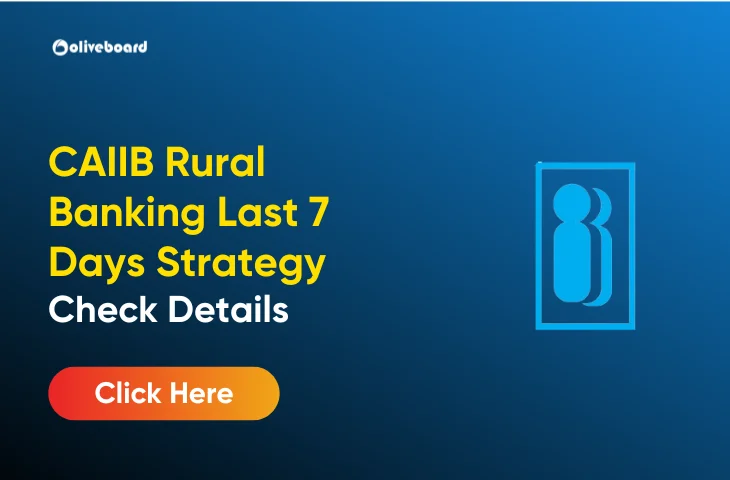CAIIB Rural Banking Strategy
CAIIB Rural Banking Strategy: Preparing for the CAIIB Rural Banking exam requires focused strategy, especially in the last 7 days before the exam. As you approach the final week, it is important to streamline your revision process and optimize your time for maximum effectiveness. This article will provide you with a detailed strategy to tackle the CAIIB Elective Rural Banking exam in the last 7 days, covering key aspects such as time management, important topics, and exam strategies.
CAIIB Rural Banking
The CAIIB Rural Banking focuses on enhancing knowledge related to banking services in rural areas, understanding rural finance, and the policies influencing rural development. The exam includes various topics such as:
- Rural Financial Institutions
- Agricultural Credit and Finance
- Microfinance and Rural Development
- Government Schemes for Rural Development
To succeed in this exam, it is important to focus on practical and conceptual knowledge, as the questions will test both your theoretical understanding and your ability to apply knowledge in real world scenarios.
CAIIB Rural Banking Last 7 Days Strategy
Day 1-3: Revising Core Concepts and Key Topics
In the first three days of the last week, focus on revising core concepts and the most important topics that frequently appear in the exam. These concepts will serve as the foundation for your exam preparation.
Key Areas to Focus On:
- Rural Financial Institutions:
- Understand the different types of rural financial institutions such as commercial banks, regional rural banks (RRBs), cooperative banks, and microfinance institutions (MFIs).
- Study their role in providing financial services to the rural economy and their impact on rural development.
- Agricultural Credit and Finance:
- Review the various schemes for agricultural credit, such as Kisan Credit Card (KCC), and financing mechanisms for farmers.
- Know the key policies like the NABARD (National Bank for Agriculture and Rural Development) policies.
- Microfinance and Rural Development:
- Focus on understanding microfinance institutions, Self-Help Groups (SHGs), and their role in financial inclusion.
- Review case studies of successful rural development programs and how financial institutions have contributed.
- Government Schemes for Rural Development:
- Study schemes like PMAY-G (Pradhan Mantri Awas Yojana – Gramin), MGNREGA (Mahatma Gandhi National Rural Employment Guarantee Act), and other rural welfare programs.
Day 4-5: Practice and Focus on Problem-Solving
After revising the core concepts, the next two days should focus on problem-solving and applying the knowledge you’ve gathered. During this period, solve CAIIB mock test, sample papers, and previous years’ question papers. This practice will give you a clear understanding of the exam format and the types of questions that are frequently asked.
Suggested Approach:
- Time Management: Simulate exam-like conditions and solve mock papers in the allotted time. This will help you manage time effectively during the actual exam.
- Concept Application: Focus on questions that require you to apply theoretical knowledge in practical situations, such as case studies or scenario-based questions.
Mock Exam Tips:
- Set a timer and try to complete the mock paper within the given time frame.
- After completing the mock exam, go through the correct answers and identify areas where you made mistakes. This will help you focus on weak areas.
Day 6: Focus on Weak Areas and Clarify Doubts
By now, you should have identified your weak areas. Use Day 6 to focus on these concepts and clarify any doubts you may have. If there are any specific topics or questions you find challenging, take the time to understand them better.
Strategies for Day 6:
- Clarify Doubts: Reach out to mentors, teachers, or peers to clarify any doubts or confusion about specific topics.
- Revisit Key Formulas and Definitions: Go over important formulas, key terms, and definitions related to rural banking and finance.
- Focus on Short Notes: Create short notes or flashcards for quick revision, especially for policies, government schemes, and important dates.
Day 7: Last-Minute Revision and Relaxation
On the final day before the exam, do not try to cram new information. Instead, focus on last-minute revision and relax to ensure you are calm and focused on exam day.
Key Activities for Day 7:
- Go Through Short Notes:
- Quickly review your short notes or flashcards to keep key concepts fresh in your mind.
- Relax and Stay Calm:
- Avoid over-studying. It’s essential to relax and get adequate rest before the exam. A calm mind will help you perform better.
- Review Key Policies and Schemes:
- Skim through important government schemes and policies that are frequently tested in the exam.
- Focus on Strategy for the Exam:
- Have a strategy for attempting the exam. Start with questions you are most comfortable with and leave the difficult ones for later.
Time Management Strategy for the CAIIB Rural Banking Exam
Effective time management is important during the last week of preparation. Follow this time allocation strategy to maximize your revision:
| Time of Day | Activity |
| Morning (2-3 hours) | Revise core topics and make notes. Focus on important concepts. |
| Midday (2 hours) | Solve mock tests or past year papers. Identify weak areas. |
| Afternoon (1 hour) | Take a break or engage in light reading to refresh your mind. |
| Evening (2 hours) | Focus on problem-solving and revisiting doubts. Review short notes. |
Final Tips for Success in the CAIIB Rural Banking Exam
- Stay Consistent: In the last 7 days, consistency is key. Make sure to revise each day without skipping any topic.
- Understand the Exam Pattern: Familiarize yourself with the exam pattern and types of questions asked in the CAIIB Rural Banking paper.
- Use Real-World Examples: Try to link theoretical concepts to real-world examples for better understanding and application.
- Stay Positive: Believe in your preparation and stay positive. A calm and confident mindset will lead you to success.
Conclusion
The CAIIB Rural Banking Last 7 Days Strategy involves a focused approach that balances revision, practice, and relaxation. By following this structured strategy, you can maximize your chances of success in the CAIIB Rural Banking elective exam. Prioritize the key concepts, practice regularly, and stay calm during the final days. Remember, success comes from consistent effort and a positive mindset.
CAIIB Rural Banking Last 7 Days Strategy – FAQs
Ans. Focus on revising key concepts, practicing mock tests, and reviewing previous year’s papers for time management.
Ans. Prioritize solving practice questions under timed conditions to enhance speed and accuracy.
Ans. Avoid studying new topics; focus on revision and consolidating what you’ve already learned.
Ans. Use concise notes, mock tests, and previous years’ papers to ensure thorough revision and practice.
- CAIIB BRBL Questions with Detailed Solutions and Answers

- CAIIB Previous Year Question Paper, Download Free PDF

- CAIIB Electives Exam Analysis 2025, December All Paper Review

- CAIIB BRBL Exam Analysis 2025, December Cycle Review

- CAIIB ABFM Exam Analysis 2025, 13th December Review

- CAIIB BFM Exam Analysis 2025, 7th December Difficulty Level


Hello there! I’m a dedicated Government Job aspirant turned passionate writer & content marketer. My blogs are a one-stop destination for accurate and comprehensive information on exams like Regulatory Bodies, Banking, SSC, State PSCs, and more. I’m on a mission to provide you with all the details you need, conveniently in one place. When I’m not writing and marketing, you’ll find me happily experimenting in the kitchen, cooking up delightful treats. Join me on this journey of knowledge and flavors!
